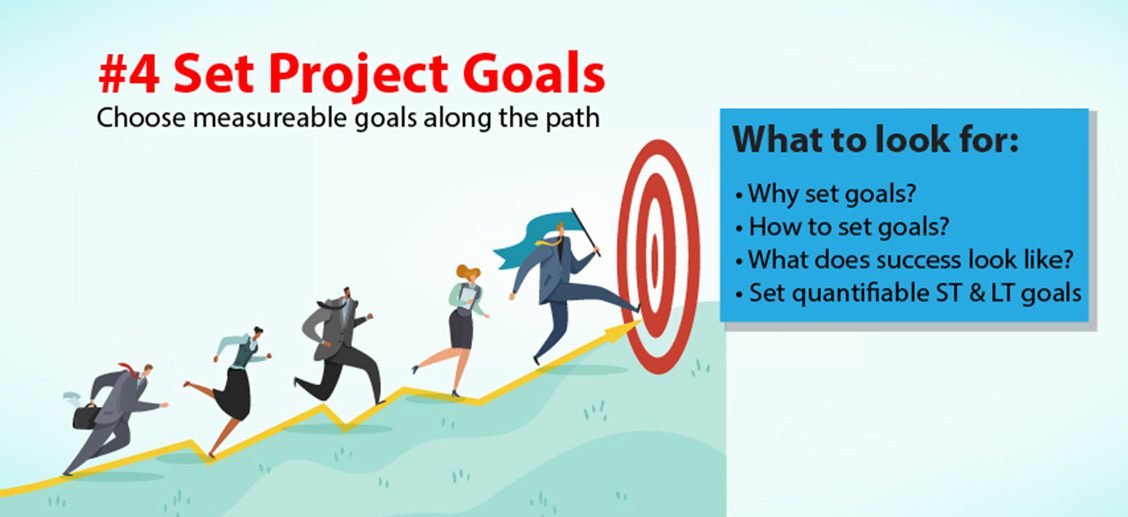#4 in the new Blog Series: How to Evaluate Legal Operations Solutions
Evaluating Legal Ops Solutions: Fourth, Set goals that drive project success
Now that you’ve created your evaluation team, asked the right questions, and determined the actual needs of your legal department that technology must address, it’s time to take the next step by setting clear, actionable, and quantifiable goals.
Why set goals?
Goal-setting is an indispensable part of the evaluation process because, without it, you’re “flying blind” and will have no measurable way of knowing whether or when you reach your destination. Clearly defined goals will:
- Make sure teams are on the same page and reading from the “same sheet of music”
- Eliminate doubt, fear, and uncertainty
- Ensure all activities contribute to meaningful results.
Ninja Tip: All goals have to meet some higher purpose. Ensure reaching the goal will offer some tangible benefit to the business. Setting goals using this mentality may provide needed additional support for the “buy-in” that will come later.

How to set goals
One of the best examples of a specific and quantifiable goal is President John F. Kennedy’s speech in 1961 where he promised to put a man on the moon by the end of the decade. It was clearly defined and had an end date to measure success or failure. He understood this concept and his persistence ensured that we reached that goal.
A simple method for setting goals is the use of the SMART system, where the letters of SMART stand for Specific, Measurable, Actionable, Realistic, and Time-sensitive.
- Specific goals are clear and well-defined, such as creating a new business model for acquisitions that will involve Legal, Finance, and Operations and take into account revenue contribution, market share, and go-live schedules that drive in-house team efficiency.
- Measurable means that the goal must be able to have metrics that are trackable and have relevant numbers associated with them.
- Unmeasurable goal example: Have a more positive impact on public feedback ratings.
- Measurable goal example: Improve our public relations feedback ratings 10% by the end of the year.
- Actionable indicates the goal will be affected by our by taking actions directly or driving action in others indirectly.
- Leveraging our existing relationships with outside influencers, so they can drive greater attendance to events in order to hear the value proposition.
- Require our existing subject matter experts to attend outside sponsorship events, so more prospects will hear our value proposition message, see product demos in-person, improve feedback, and improve sales as a result.
- Realistic relies on real-world possibilities.
- Is the goal attainable with all limitations presented?
- Can you reach the goal in the timeframe given for the project?
- Do you have the resources you need to attain the goal?
- Time-sensitive means you must set a timeframe in which to achieve the goal. Try scheduling milestones in the months to come – mini-steps that keep the team motivated along the way. For example, “we will reduce outside vendor costs by 50% in the next six months.”
Ninja tip: Don’t redesign the wheel. Stick to the proven SMART framework because it sets the bar for every measure of success without overthinking the options or possibilities. Keep it simple.
What does success look like?
This has a few variables because you and your team, as well as your business, have desired outcomes. Success can be personal and professional. Work together to come up with the best outcome for all. Here’s the best way to create your own vision of business success:
- How will these goals drive future business growth?
- Will this project be the foundation for future projects?
- If goals are not met, what are the repercussions, both business and personal?
Ninja tip: You and your team have been brought together to drive success for your business. Ensure your attitudes and discussions focus on the successful business gains. Any personal successes (raises, promotions, etc.) will follow naturally.
Set Quantifiable goals for short-term (ST = now through the first year)
First, take small steps:
- Establish short-term goals (“milestones”) to keep teams engaged and encouraged
- Short-term goals may also help prove the project in stages to maintain budget funding and instill confidence that overall goals will be met.
Set Quantifiable goals for long-term (LT = through the next 3-5 years)
This stage will help you develop a solid strategy to meet the business goals you were given:
- Long-term goals are focused on final outcomes and may include goals that go beyond the initial project.
- Long-term goals are most often the results on which the project will be ultimately judged.
Ninja tip: The internal team created for this project will be a great resource for their individual business unit’s desired results. By combining all of these, you’ll need to distill these down to the overall business ST & LT goals for evaluating legal technology solutions.
Conclusion
By setting goals early in the project, you are establishing the rules and guidelines to keep the legal technology evaluation project on track and heading in the right direction. It is the team leader’s responsibility to measure the progress and report on each of the goals. It is the team member’s responsibility to bring up any shortcomings to the leader’s attention ASAP. This teamwork provides the foundation for success.
Ninja tip: Provide a visual way to always see the goals. A poster or dry-erase board in your team room works well. When you meet, make sure everyone can see the goals to keep them top of mind.
Next installment: Watch for Dealbreakers
Once you have established specific, measurable goals, the “dealbreakers” will be easier to identify. Make sure everyone is aware of these to have more eyes on the target. Working as a team helps provide a clear and actionable path around obstacles that threaten the final success.
Remember that not all “dealbreakers are set-in-stone” throughout the evaluation process. Things can change in your favor, but others might cause problems. Dealbreakers can crop up or change at any time. This “moving dealbreaker” concept is a fluid part of any project lifecycle, so be prepared for some unexpected course corrections.
While every company’s checklist will vary, yours should look something like this:
- Assemble the team (Read this post)
Start a conversation with leaders in every business unit that touches yours, and, if appropriate, invite them to be part of your evaluation team. - Ask incisive questions (Read this post)
Get to the heart of the business issue and identify a quantifiable goal. - Evaluate the need (Read this post)
Consider whether the need is great enough to commit your collective resources. - Set goals (You’re reading this post)
Look at quantifiable goals for short-term (now through the next year) and longer-term (through the next 3-5 years) time periods. Make them measurable. - Watch for deal breakers
Discuss what, if anything, would jeopardize a decision. - Gather evidence
Encourage members who are not part of your own unit to share challenges they face in theirs and what they’re doing to overcome them. - Follow best practices
It’s quite possible that examples of what other teams have done will include a formal or informal list of best practices – or at least some insights for creating that list.





